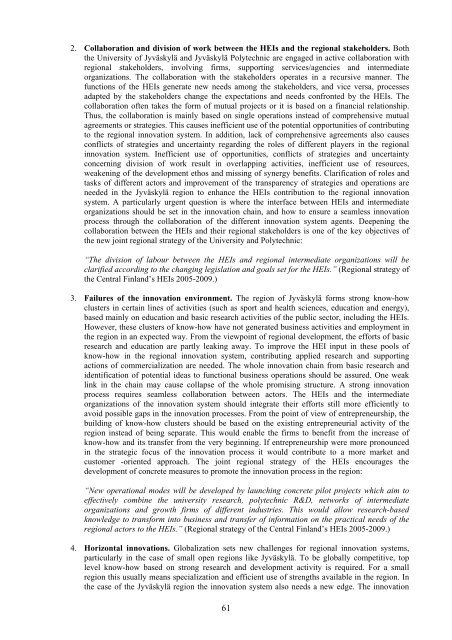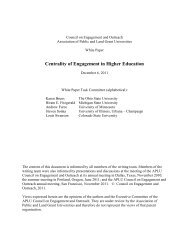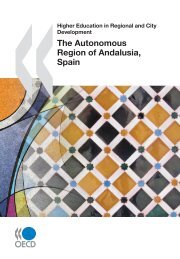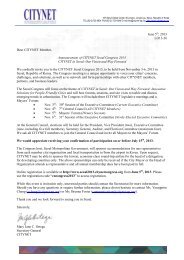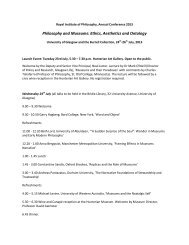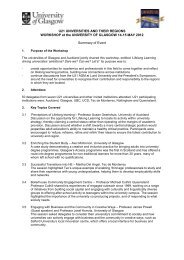2. Collaboration and division of work between the HEIs and the regional stakeholders. Boththe University of Jyväskylä and Jyväskylä Polytechnic are engaged in active collaboration withregional stakeholders, involving firms, supporting services/agencies and intermediateorganizations. The collaboration with the stakeholders operates in a recursive manner. Thefunctions of the HEIs generate new needs among the stakeholders, and vice versa, processesadapted by the stakeholders change the expectations and needs confronted by the HEIs. Thecollaboration often takes the form of mutual projects or it is based on a financial relationship.Thus, the collaboration is mainly based on single operations instead of comprehensive mutualagreements or strategies. This causes inefficient use of the potential opportunities of contributingto the regional innovation system. In addition, lack of comprehensive agreements also causesconflicts of strategies and uncertainty regarding the roles of different players in the regionalinnovation system. Inefficient use of opportunities, conflicts of strategies and uncertaintyconcerning division of work result in overlapping activities, inefficient use of resources,weakening of the development ethos and missing of synergy benefits. Clarification of roles andtasks of different actors and improvement of the transparency of strategies and operations areneeded in the Jyväskylä region to enhance the HEIs contribution to the regional innovationsystem. A particularly urgent question is where the interface between HEIs and intermediateorganizations should be set in the innovation chain, and how to ensure a seamless innovationprocess through the collaboration of the different innovation system agents. Deepening thecollaboration between the HEIs and their regional stakeholders is one of the key objectives ofthe new joint regional strategy of the University and Polytechnic:“The division of labour between the HEIs and regional intermediate organizations will beclarified according to the changing legislation and goals set for the HEIs.” (<strong>Region</strong>al strategy ofthe Central <strong>Finland</strong>’s HEIs 2005-2009.)3. Failures of the innovation environment. The region of Jyväskylä forms strong know-howclusters in certain lines of activities (such as sport and health sciences, education and energy),based mainly on education and basic research activities of the public sector, including the HEIs.However, these clusters of know-how have not generated business activities and employment inthe region in an expected way. From the viewpoint of regional development, the efforts of basicresearch and education are partly leaking away. To improve the HEI input in these pools ofknow-how in the regional innovation system, contributing applied research and supportingactions of commercialization are needed. The whole innovation chain from basic research andidentification of potential ideas to functional business operations should be assured. One weaklink in the chain may cause collapse of the whole promising structure. A strong innovationprocess requires seamless collaboration between actors. The HEIs and the intermediateorganizations of the innovation system should integrate their efforts still more efficiently toavoid possible gaps in the innovation processes. From the point of view of entrepreneurship, thebuilding of know-how clusters should be based on the existing entrepreneurial activity of theregion instead of being separate. This would enable the firms to benefit from the increase ofknow-how and its transfer from the very beginning. If entrepreneurship were more pronouncedin the strategic focus of the innovation process it would contribute to a more market andcustomer -oriented approach. The joint regional strategy of the HEIs encourages thedevelopment of concrete measures to promote the innovation process in the region:“New operational modes will be developed by launching concrete pilot projects which aim toeffectively combine the university research, polytechnic R&D, networks of intermediateorganizations and growth firms of different industries. This would allow research-basedknowledge to transform into business and transfer of information on the practical needs of theregional actors to the HEIs.” (<strong>Region</strong>al strategy of the Central <strong>Finland</strong>’s HEIs 2005-2009.)4. Horizontal innovations. Globalization sets new challenges for regional innovation systems,particularly in the case of small open regions like Jyväskylä. To be globally competitive, toplevel know-how based on strong research and development activity is required. For a smallregion this usually means specialization and efficient use of strengths available in the region. Inthe case of the Jyväskylä region the innovation system also needs a new edge. The innovation61
system of Jyväskylä and the HEIs of the region include some strong horizontal lines of business(such as ICT and education sector), which form a good seed-bed for horizontal innovations. Thispotential for horizontal innovations could be more efficiently used by an active identification ofthe possibilities to apply innovations, developed in the region or imported outside, in some newlines of activities. The horizontal innovations could act as a stimulus for specialization as well.However, the actual outcome of horizontal innovation requires profound and intensivecollaboration between the University and the Polytechnic, as well as between the HEIs and theirstakeholders. The mutual operations of HEIs and their regional stakeholders for supportinghorizontal innovations are dawning in the Jyväskylä region and first significant steps towardsnew application fields based on regional strengths are being taken. Wellness technology,combination of paper and information technology, learning and psychology integrated to ICTapplicationsand new types of bioenergy applications are some examples of this next generationof innovations emerging in the Jyväskylä region.5. Top down vs. bottom up inspirations – regional confronting of the “triple helix”. Thenational innovation system of <strong>Finland</strong> is based on a “triple helix” interaction between thegovernment, industry and HEIs. This interaction forum constructs the top-down guidelines forthe national system of innovation. Herein, the key question is how this top-down based nationalsystem interacts with the bottom-up initiatives of individual regions (cf. OECD, 2005).Accordingly, the challenge confronted by the national innovation system is to be ablesimultaneously to contribute both to national innovative performance and to aspirations for amore balanced regional development. From the viewpoint of regions, the critical question is howthese national ambitions match with the strategic tendencies of the regional innovation system.In the Jyväskylä region the current national framework and short-run future strategies of thenational innovation system meet the regional aspirations quite well. However, it is veryimportant to evaluate the possible regional conflicts of the top-down strategy, where the regionaland the national aspirations are not convergent, causing the conflicts in strategies and actionsbetween regionally coordinated actors and actors representing ministries and national innovationagencies involved directly in triple helix system. Generally, adjusting the national and regionalpriorities is needed to make the tripartite interaction efficiently espoused and executed in theregional innovation systems.6. Capability to exploit the know-how of HEIs. Even if the HEIs make the best possible knowhowavailable for the actors of the regional innovation system, it does not guarantee its effectiveutilization in the region. The potential customers and/or partners in business and the publicsector should be capable of receiving and processing the know-how based on HEI activities.However, there seem to be many obstacles preventing an effective use of the expertise providedby the HEIs. Firstly, the potential users may be uncertain or have confusing information on thekinds of services offered by the HEIs. Secondly, the expertise offered by the HEIs can be in aninappropriate form compared to the capability of the potential customers to use it, and hence,would need modifying for easier utilization. Thirdly, the expertise available can be far tooexpensive, especially for small enterprises to utilize. Despite the obstacles behind poorexploitation of the knowledge and know-how provided by the HEIs, they can be usuallyremoved through closer collaboration between stakeholders and HEIs, and by developing newways of providing and delivering the expertise, i.e., through organizational, process and socialinnovations.62
- Page 1 and 2:
OECD/IMHE ‐ Supporting thecontrib
- Page 3 and 4:
SUMMARYTogether with 13 other regio
- Page 5 and 6:
8.2 Increasing the regional effecti
- Page 7 and 8:
I INTRODUCTION1.1 Strengthening the
- Page 9 and 10:
development. The aim is that region
- Page 11 and 12: The self-evaluation considered here
- Page 13 and 14: densely populated cities in Finland
- Page 15 and 16: 1,9 %1,7 %1,5 %1,3 %Population chan
- Page 17 and 18: The share of jobs in primary produc
- Page 19 and 20: New pillars of future’s developme
- Page 21 and 22: Jyväskylä0,60,91,11,0Central Finl
- Page 23 and 24: 2.4 Governance StructureMunicipalit
- Page 25 and 26: of its development outside the cent
- Page 27 and 28: III CHARACTERISTICS OF THE HIGHER E
- Page 29 and 30: continuing education and open unive
- Page 31 and 32: The Science and Technology Policy C
- Page 33 and 34: 3.2 Regional dimension within the n
- Page 35 and 36: order to respond to the challenges
- Page 37 and 38: 14001200Master's degreesDoctoratesN
- Page 39 and 40: 900800Youth graduatedAdult graduate
- Page 41 and 42: provide information for the basis o
- Page 43 and 44: CabinetParliamentSTPCSteering (andf
- Page 45 and 46: 5,04,0Billion euros3,02,01,00,083 8
- Page 47 and 48: The number of refereed articles is
- Page 49 and 50: Centre of expertisePaper industryBi
- Page 51 and 52: The Institute for Environmental Res
- Page 53 and 54: and systematic gradually progressin
- Page 55 and 56: are seen to be very important chann
- Page 57 and 58: Internal support units of HEIsThe F
- Page 59 and 60: of interviewed HEI staffs, the coop
- Page 61: areas of the region’s Centre of E
- Page 65 and 66: V CONTRIBUTION OF TEACHING AND LEAR
- Page 67 and 68: esources to establish new activitie
- Page 69 and 70: The main problem for the Finnish la
- Page 71 and 72: longer. 2.5% of the Jyväskylä Pol
- Page 73 and 74: activities. As a part of the new qu
- Page 75 and 76: education programmes consisting of
- Page 77 and 78: the TE-Centre of Central Finland an
- Page 79 and 80: practices in the provision of educa
- Page 81 and 82: Reason forskillupgradingDescription
- Page 83 and 84: Strengths+ HEIs are actively confro
- Page 85 and 86: taxation, to lower the unemployment
- Page 87 and 88: Box 6.2 The WIRE -projects: Support
- Page 89 and 90: indoor ice-skating rink, the Rauhal
- Page 91 and 92: The School of Cultural Studies at t
- Page 93 and 94: the number of registered customers
- Page 95 and 96: Box 6.9 Environmental management in
- Page 97 and 98: Strengths+ The significance of HEIs
- Page 99 and 100: eferring to the regional developmen
- Page 101 and 102: Key topics relating to changes in t
- Page 103 and 104: participation in the decision makin
- Page 105 and 106: in the strategy-making process. The
- Page 107 and 108: 7.5 Critical points in promoting th
- Page 109 and 110: 7.Cooperation in strategies concern
- Page 111 and 112: egion is according to national and
- Page 113 and 114:
oundaries for further developmental
- Page 115 and 116:
joining resources and operations by
- Page 117 and 118:
Discussion proposal 15: To ensure d
- Page 119 and 120:
achieved by the horizontal utilizat
- Page 121 and 122:
Appendix 2 Information on data used
- Page 123 and 124:
and finding synergy between the oth
- Page 125 and 126:
School of BusinessRoleThe School of
- Page 127 and 128:
The challenge of the school from re
- Page 129 and 130:
developing wellness and environment
- Page 131 and 132:
Faculty of EducationRoleThe Faculty
- Page 133 and 134:
and/or graduation thesis is a signi
- Page 135 and 136:
Areas of strength and prioritising
- Page 137 and 138:
Agora Center’s partners from the
- Page 139 and 140:
Currently the priority of ITRI’s
- Page 141 and 142:
Weak spots and areas to develop in
- Page 143 and 144:
Employment and Economic Development
- Page 145 and 146:
Appendix 3 Analysis of the most sig
- Page 147 and 148:
Appendix 4 Regional effects (input-
- Page 149 and 150:
The overall value of production cre
- Page 151 and 152:
Appendix 5 Reform of regional struc
- Page 153 and 154:
Appendix 7 Provision of education i
- Page 155 and 156:
Appendix 8 Statistical information
- Page 157 and 158:
Appendix 10 Statistics on financing
- Page 159 and 160:
Appendix 12 Labour market activity
- Page 161 and 162:
Appendix 14 Master’s Programmes a
- Page 163 and 164:
Uusiutuvan energian tutkimusohjelma
- Page 165 and 166:
BIBLIOGRAPHYAcademy of Finland (200


